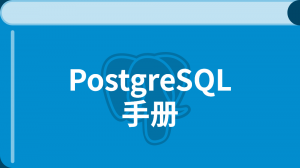PostgreSQL hstore
- F.16.1.
hstore外部表示 - F.16.2.
hstore操作符和函数 - F.16.3. 索引
- F.16.4. 例子
- F.16.5. 统计
- F.16.6. 兼容性
- F.16.7. 转换
这个模块实现了hstore数据类型用来在一个单一PostgreSQL值中存储键值对。这在很多情景下都有用,例如带有很多很少被检查的属性的行或者半结构化数据。键和值都是简单的文本字符串。
这个模块被视为“trusted”,也就是说,它可以由对当前数据库具有CREATE权限的非超级用户安装。
F.16.1. hstore 外部表示
一个hstore的文本表示用于输入和输出,包括零个或者多个由逗号分隔的key => value对。一些例子:
k => v
foo => bar, baz => whatever
"1-a" => "anything at all"
键值对的顺序没有意义(并且在输出时也不会重现)。键值对之间或者=>号周围的空白会被忽略。双引号内的键和值可以包括空白、逗号、=或>。要在一个键或值中包括一个双引号或一个反斜线,用一个反斜线对它转义。
一个hstore中的每一个键是唯一的。如果你声明了一个有重复键的hstore,只有一个会被存储在hstore中并且无法保证哪一个将被保留:
SELECT 'a=>1,a=>2'::hstore;
hstore
----------
"a"=>"1"
一个值(但不是一个键)能够是一个 SQL NULL。例如:
key => NULL
NULL关键词是大小写不敏感的。将NULL放在双引号中可以将它当作一个普通的字符串“NULL”。
注意
记住当hstore文本格式当被用于输入时,它应用在任何必须的引用或转义之前。如果你通过一个参数传递一个hstore文字,那么不需要额外的处理。但是如果你将它作为一个引用的文字常数,那么任何单引号字符以及(取决于standard_conforming_strings配置参数的设置)反斜线字符需要被正确地转义。更多关于处理字符串常量的处理可见
第 4.1.2.1 节。
在输出时,双引号总是围绕着键和值,即使这样做不是绝对必要。
F.16.2. hstore 操作符和函数
hstore模块所提供的操作符显示在表 F.7中,函数在表 F.8中。
表 F.7. hstore 操作符
|
操作符 描述 例子 |
|---|
|
返回与给定键相关联的值,如果不存在则返回 |
|
返回与给定键(多个)相关联的值,如果不存在则返回 |
|
连接两个 |
|
|
|
|
|
|
|
左操作符包含右操作符吗? |
|
左操作符包含在右操作符里面吗? |
|
从左操作符删除键。 |
|
从左操作符删除键(多个)。 |
|
从左操作符中删除与右操作符中的对(pairs)相匹配的对。 |
|
用 |
|
将 |
|
将 |
注意
在 PostgreSQL 8.2 之前,包含操作符@>和<@分别被称为@和~。这些名称仍然可用,但是已经被弃用并且最终将被移除。注意,旧名称和原来核心几何数据类型所遵循的习惯是相反的!
表 F.8. hstore 函数
F.16.3. 索引
hstore有对@>、?、?&和?|操作符的 GiST 和 GIN 索引支持。例如:
CREATE INDEX hidx ON testhstore USING GIST (h);
CREATE INDEX hidx ON testhstore USING GIN (h);
gist_hstore_ops GiST 操作符类(opclass)将一组键/值对近似计算为位图签名。它的可选整数参数siglen决定了签名的字节长度。 默认长度为16字节。签名长度的有效值在1到2024字节之间。 更长的签名将导致更精确的搜索(扫描更小的索引部分和更少的堆页),以更大的索引为代价。
建立这样的一个带有32字节签名长度的示例:
CREATE INDEX hidx ON testhstore USING GIST (h gist_hstore_ops(siglen=32));
hstore也为=操作符支持btree或hash索引。这允许hstore列被声明为UNIQUE或者被使用在GROUP BY、
ORDER BY或DISTINCT表达式中。hstore值的排序顺序不是特别有用,但是这些索引可能对等值查找有用。为=比较创建以下索引:
CREATE INDEX hidx ON testhstore USING BTREE (h);
CREATE INDEX hidx ON testhstore USING HASH (h);
F.16.4. 例子
增加一个键,或者用一个新值更新一个现有的键:
UPDATE tab SET h = h || hstore('c', '3');
删除一个键:
UPDATE tab SET h = delete(h, 'k1');
将一个record转换成一个hstore:
CREATE TABLE test (col1 integer, col2 text, col3 text);
INSERT INTO test VALUES (123, 'foo', 'bar');
SELECT hstore(t) FROM test AS t;
hstore
---------------------------------------------
"col1"=>"123", "col2"=>"foo", "col3"=>"bar"
(1 row)
将一个hstore转换成一个预定义的record类型:
CREATE TABLE test (col1 integer, col2 text, col3 text);
SELECT * FROM populate_record(null::test,
'"col1"=>"456", "col2"=>"zzz"');
col1 | col2 | col3
------+------+------
456 | zzz |
(1 row)
用来自于一个hstore的值修改一个现有的记录:
CREATE TABLE test (col1 integer, col2 text, col3 text);
INSERT INTO test VALUES (123, 'foo', 'bar');
SELECT (r).* FROM (SELECT t #= '"col3"=>"baz"' AS r FROM test t) s;
col1 | col2 | col3
------+------+------
123 | foo | baz
(1 row)
F.16.5. 统计
由于hstore类型本质的宽大性,它能够包含一些不同的键。检查合法键是应用的任务。下列例子验证了用于检查键以及获得统计的一些技术。
简单例子:
SELECT * FROM each('aaa=>bq, b=>NULL, ""=>1');
使用一个表:
SELECT (each(h)).key, (each(h)).value INTO stat FROM testhstore;
在线统计:
SELECT key, count(*) FROM
(SELECT (each(h)).key FROM testhstore) AS stat
GROUP BY key
ORDER BY count DESC, key;
key | count
-----------+-------
line | 883
query | 207
pos | 203
node | 202
space | 197
status | 195
public | 194
title | 190
org | 189
...................
F.16.6. 兼容性
从 PostgreSQL 9.0 开始,hstore使用了与之前版本不同的内部表示。这不会为转储/恢复升级造成障碍,因为文本表示(用于转储)没有改变。
在一次二进制升级中,通过让新代码识别旧格式数据来维持向上兼容。当处理还没有被新代码修改过的数据时,这会带来一定的性能惩罚。可以通过执行一个下面的UPDATE语句来强制升级表中的所有值:
UPDATE tablename SET hstorecol = hstorecol || '';
另一种方法:
ALTER TABLE tablename ALTER hstorecol TYPE hstore USING hstorecol || '';
ALTER TABLE方法要求表上的一个排他锁,但是不会导致表因为旧行版本而膨胀。
F.16.7. 转换
有一些额外的扩展为语言 PL/Perl 和 PL/Python 实现了hstore
类型的转换。用于 PL/Perl 的扩展叫做hstore_plperl和 hstore_plperlu,分别用于可信的和不可信的 PL/Perl。 如果安装这些转换并且在创建函数时指定它们,hstore值会被
映射成 Perl 哈希。用于 PL/Python 的扩展是hstore_plpythonu、 hstore_plpython2u和hstore_plpython3u( PL/Python 命名习惯见第 45.1 节)。如果使用它们,
hstore值会被映射成 Python 字典。
小心
强烈建议将转换扩展安装在与hstore相同的模式中。否则,如果转换扩展的模式包含敌对用户定义的对象,就会存在安装时的安全隐患。

